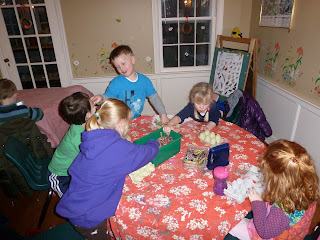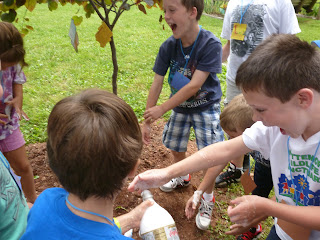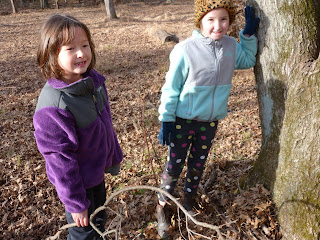The Roving Nature Center
and the Whittemore Wildlife Sanctuary
Welcome!
Welcome to our blog! We are excited to share pictures, stories and videos about our nature programs to you. Stay tuned for posts for all of our summer camp locations
Tuesday, June 19, 2012
Summer Camp 2012
Tuesday, March 6, 2012
Maple Magic! Poems and Pictures
The first ever Maple Tree Clubs culminated last week with pancake and maple syrup feasts; quite the sweet conclusion. This is what the maple scientists (ages 6-9) had to say about their adopted maple trees:
Green as the
Grass, Brown
as my hair
Light as a
Cloud, nice as
a deer, but
the thing
I love is
a secret
I love you so much
I could kiss you!
written by "White Dove"
you must first get
a tree
Mine is friendly
as a tree can be
The tree is very
nice and it has no mice on a
windy day it's
branch may snap
But anyway
anywhere I love
my tree in the
forest.
written by "Diving Falcon"
My tree is good
my tree is nice
with sap to make
maple syrup.
Ants crawl
all over the tree
and that is why it's good
you see
Thank you tree
Thank you tree
Thank you so much
for the delicious
syrup I slurp upon
my spoon this is soo
good it makes me
smile
Green as the
Grass, Brown
as my hair
Light as a
Cloud, nice as
a deer, but
the thing
I love is
a secret
written by "Beauty Bird"
I could kiss you!
For yummy maple
syrup so golden you must first get
a tree
Mine is friendly
as a tree can be
The tree is very
nice and it has no mice on a
windy day it's
branch may snap
But anyway
anywhere I love
my tree in the
forest.
written by "Diving Falcon"
my tree is nice
with sap to make
maple syrup.
Ants crawl
all over the tree
and that is why it's good
you see
written by "Diving Dolphin"
Thank you tree
Thank you so much
for the delicious
syrup I slurp upon
my spoon this is soo
good it makes me
smile
written by "Ninja Snake"
 |
| We love our adopted tree! |
 |
| Mr. Mike evaporating the sap |
 |
| Miss Marissa showing off the boiled down sap |
 |
| The Maple Scientists Exploring the Forest |
 |
| After tapping their adopted trees |
 |
| After writing their tree poems, scientists warm up by the stove |
 |
| Drip, drip, drip! |
 |
| Playing forest games |
 |
| Exploring a decomposing log |
 |
| Writing tree poems |
 |
| We rock! |
 |
| The final day, enjoying pancakes with syrup and listening to poems |
 |
| Saplings checking out their sap bucket with Mr. Mike |
Tuesday, January 3, 2012
Winter Wonder Camp
The camp was a fantastic experience for both teachers and campers. It was a great way to flex some muscles and imaginations during the holidays! We had beautiful weather and saw many kinds of birds at our new feeder station and on the trail: dark-eyed juncos, eastern bluebirds, red bellied woodpeckers, blue jays and hundreds of robins. Even our boisterous group of 13 three-five year olds got to see some wildlife during our winter scavenger hunt! Our older red foxes became especially tuned in to nature by paying close attention to the day length and bird sounds. On the last day during snack, they all started squeezing our toy Audubon birds and quizzing each other (and me!) on bird songs! Both groups made fantastic shelters for their 'jello' babies (jello mixed with water in a cup and left over night in a natural shelter).
Despite cold temperatures, all jello babies survived the night and were still liquid thanks to some hard working kids! To offset the lack of snow, foxes grew their own snow crystals and took home snow catching "kits" to be kept cold until the next snowfall. Both groups enjoyed fun outdoor games and creating yummy shelters to eat for their teddy bears.
For the first time at camp, we scheduled in "exploring time." As the center grows, kids seem to have an affinity for just exploring. It seemed only natural to me to officially schedule time for this into the schedule. After explaining the rules, the kids took off and had a blast bird watching at our new feeder area, looking at our new live crickets, dragonfly nymphs, snails and box turtle, writing or drawing in our turtle and bird watching journals, reading books, playing with our toy bird stuffed animals and animal puppets, drawing on the chalkboard, examining feathers and bug books with magnifying glasses and touching the real stuffed animals and skulls and shells. After snack time, all campers got to feed Herman the Worm. I have a few more ideas to implement this winter as well: place a baby monitor at the bird feeder station to hear the birds, create a sandbox animal track play area and re-do our touch box.
Thanks for supporting us for this new camp! We couldn't have done it without you! Stay tuned to more new programs in the spring!
Miss Marissa
Despite cold temperatures, all jello babies survived the night and were still liquid thanks to some hard working kids! To offset the lack of snow, foxes grew their own snow crystals and took home snow catching "kits" to be kept cold until the next snowfall. Both groups enjoyed fun outdoor games and creating yummy shelters to eat for their teddy bears.
For the first time at camp, we scheduled in "exploring time." As the center grows, kids seem to have an affinity for just exploring. It seemed only natural to me to officially schedule time for this into the schedule. After explaining the rules, the kids took off and had a blast bird watching at our new feeder area, looking at our new live crickets, dragonfly nymphs, snails and box turtle, writing or drawing in our turtle and bird watching journals, reading books, playing with our toy bird stuffed animals and animal puppets, drawing on the chalkboard, examining feathers and bug books with magnifying glasses and touching the real stuffed animals and skulls and shells. After snack time, all campers got to feed Herman the Worm. I have a few more ideas to implement this winter as well: place a baby monitor at the bird feeder station to hear the birds, create a sandbox animal track play area and re-do our touch box.
Thanks for supporting us for this new camp! We couldn't have done it without you! Stay tuned to more new programs in the spring!
Miss Marissa
 |
| Making graham cracker shelters for teddy bears |
 |
| Jello Baby Shelter |
 |
| Jello baby shelter |
 |
| Enjoying the sunshine |
 |
| Mouse vs fox game |
 |
| Feeding time for BJ |
 |
| Penguin Game! |
 |
| Bird watching |
 |
| Hiking |
 |
| Mouse vs fox game! |
 |
| Making re-used bird feeders out of egg cartons-YUM! |
 |
| Exploring the crickets |
 |
| Future scientists |
 |
| Me taking a break |
 |
| Taking a break during a long hike |
 |
| Hike! |
 |
| Looking for birds |
Tuesday, September 6, 2011
Meet BG the Box Turtle!
Come to Whittemore and meet our newest resident, Brown Green (or BG), a female eastern box turtle! A local boy named Alexandro Cosmo donated him to us because his family was moving to Italy and he couldn't take BG with him. We are lucky to have BG and are in the process of creating a new habitat for him, out of a baby pool. If you stop by with food (fruits, veggies, worms, slugs-yum!) you can even feed her. You can also meet her at the Tewksbury Harvest Festival on 9/24.
BG will also serve as an ambassador to all wild box turtles. If you see a box turtle in the wild, never take it home! BG was bred in captivity.
Here is some information on Eastern Box Turtles from Davidson College:
BG will also serve as an ambassador to all wild box turtles. If you see a box turtle in the wild, never take it home! BG was bred in captivity.
Here is some information on Eastern Box Turtles from Davidson College:
Eastern box turtles are amazingly versatile animals and inhabit a wide variety of habitats from wooded swamps to dry, grassy fields. Although these turtles can live in a variety of different habitats, they are most abundant and healthy in moist forested areas with plenty of underbrush. Although not aquatic, box turtles will often venture into shallow water at the edge of ponds or streams or in puddles. Box turtles do not travel far, usually living within an area less than 200m in diameter. In cold climates they hibernate through the winter in loose soil at a depth of up to two feet.
Box turtles are omnivores in the broadest sense of the word. They will eat almost anything, animal or plant, that they can fit in their mouth. Intriguingly, it is thought that young box turtles are primarily carnivorous and that as they grow their diet shifts more and more towards plant material. Favorite foods include almost any insect (although they seem to particularly relish worms and slugs), virtually any fruit or berry, mushrooms, a variety of vegetable matter, and even carrion. Interestingly, box turtles are even able to eat many mushrooms that are toxic to humans.
Although box turtles are still fairly common over much of their range, their future is uncertain. Box turtles are slow growing, have few young, and have exhibited delayed sexual maturity. These qualities make them particularly susceptible to damage due to human activities. First and foremost among problems faced by box turtles is habitat destruction and fragmentation. Fragmentation is defined as the process by which natural or seminatural habitats are seperatated from similar habitats by land that is used by humans. As areas of suitable habitat become fewer and farther between, box turtle populations will decline and individual populations will become increasingly vulnerable to extinction. Confined to smaller areas, the turtles will have an increasingly difficult time finding food or mates. These small, isolated populations may suffer from inbreeding and other genetic problems. Box turtles may also wander out of their isolated habitats into the matrix (the land used by humans), where they are particularly susceptible to accidental death due to humans. Each year countless box turtles are hit by cars or trains when they attempt to cross roads or railroads. Others are accidentally killed by lawn mowers, tractors, and farm equipment.
Another concern is the capture of box turtles for the pet trade. The impact of taking turtles from the wild can be devastating to local populations. Over the span of their lifetime, female turtles will lay hundreds of eggs, but only 2-3 of these offspring will survive to adulthood. These offspring will eventually replace their elderly parents, allowing the population to remain at a stable size . But, if box turtles are taken from the wild to become pets, or are killed by human activities, they are removed from the overall breeding population, the number of offspring drops, and the overall population declines. Additionally, box turtles have a homing instinct that causes them to try to return to the place of their birth if they are moved. As a result, when box turtles that have been taken as pets are returned to the wild, they will head straight for their natal grounds. This journey causes the turtles to encounter many dangers, such as roads, predators, and humans. For these reasons, if you are looking for a pet, you should try to find a captive-bred animal or consider a different pet. (Davidson College http://www.bio.davidson.edu/people/midorcas/research/Contribute/box%20turtle/boxinfo.htm)
Monday, August 15, 2011
Roving Rangers and Junior Naturalists at Whittemore!
 |
| Parachute Butterfly Metamorphosis |
 |
| He's inside the egg, about to hatch out as a caterpillar! |
 |
| Inside the GIANT egg |
 |
| Creating a woodland collage |
 |
| Inside the giant egg! |
 |
| Shelter building! Wow, I'd sleep in there |
 |
| Hiking! |
 |
| Face painting Mr. Nick using rocks |
 |
| Look at those beautiful faces |
 |
| What did we find? |
 |
| The shelter is completed! |
Subscribe to:
Comments (Atom)










